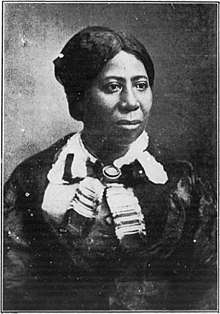Anna Murray-Douglass
| Anna Murray-Douglass | |
|---|---|
 Murray-Douglass, c. 1860 | |
| Born |
1813 Denton, Maryland, U.S. |
| Died |
August 4, 1882 (aged 68–69) Washington, D.C., U.S. |
| Nationality | American |
| Occupation | Abolitionist |
| Spouse(s) | |
| Children | 5 |
Anna Murray-Douglass (1813 – August 4, 1882) was an American abolitionist, member of the Underground Railroad, and the first wife of American social reformer and statesman Frederick Douglass, from 1838 to her death.
Early life
Anna Murray was born in Denton, Maryland, to Bambarraa and Mary Murray.[1][2] Unlike her seven older brothers and sisters, who were born in slavery, Anna Murray and her younger four siblings were born emancipated [2] her parents having been manumitted just a month before her birth.[3] A resourceful young woman, by the age of 17 she had established herself as a laundress and housekeeper and later became very wealthy.[2] Her laundry work took her to the docks, where she met Frederick Douglass,b who was then working as a caulker.[2]
Marriage
Murray's freedom made Douglass believe in the possibility of his own.[2] When he decided to escape slavery in 1838, Murray encouraged and helped him by providing Douglass with some sailor's clothing her laundry work gave her access to. She also gave him part of her savings, which she augmented by selling one of her feather beds.[2][4][5] After Douglass had made his way to Philadelphia and then New York, Murray followed him, bringing enough goods with her to be able to start a household. They were married on September 15, 1838.[2][3][5] At first they took Johnson as their name, but upon moving to New Bedford, Massachusetts, they adopted Douglass as their married name.[2]
Murray-Douglass had five children within the first ten years of the marriage: Rosetta Douglass, Lewis Henry Douglass, Frederick Douglass, Jr., Charles Remond Douglass, and Annie Douglass (Who died at the age of 10).[2] She helped support the family financially, working as a laundress and learning to make shoes, as Douglass's income from his speeches was sporadic and the family was struggling.[2] She also took an active role in the Boston Female Anti-Slavery Society and later prevailed upon her husband to train their sons as typesetters for his abolitionist newspaper, North Star.[2][3][6] After the family moved to Rochester, New York, she established a headquarters for the Underground Railroad from her home, providing food, board and clean linen for fugitive slaves on their way to Canada.[2]
Murray-Douglass received little mention in Douglass's three autobiographies. Henry Louis Gates has written that "Douglass had made his life story a sort of political diorama in which she had no role".[6] It is speculated that his long absences from home, and her feeling that as a relatively uneducated woman she did not fit in with the social circles Douglass was now moving in, led to a degree of estrangement between them that was in marked contrast to their earlier closeness.[3] Supposedly she was hurt by her husband's friendships and professional relationships with other women, but nevertheless remained loyal to Douglass's public role and the two loved each other unconditionally; her daughter Rosetta reminded those who admired her father that his "was a story made possible by the unswerving loyalty of Anna Murray."[2][6]
Later life and death
After the death of her youngest daughter Annie in 1860 at the age of 10,[7] Murray-Douglass was often in poor health. She died of a stroke in 1882 at the family home in Washington D.C.[2][6] She was initially buried at Graceland Cemetery in Washington, D.C. But the cemetery closed in 1894,[8] and on February 22, 1895, she was moved to Mount Hope Cemetery in Rochester, New York.[4][9] Frederick Douglass was buried next to her after his death on February 20, 1895.
See also
Notes
References
- ↑ Janus Adams (January 11, 2000). Sister Days: 365 Inspired Moments in African-American Women's History. John Wiley and Sons. p. 8. ISBN 978-0-471-28361-4. Retrieved 28 February 2011.
- 1 2 3 4 5 6 7 8 9 10 11 12 13 14 Julius Eric Thompson; James L. Conyers (2010). The Frederick Douglass Encyclopedia. ABC-CLIO. pp. 124–125. ISBN 978-0-313-31988-4. Retrieved 27 February 2011.
- 1 2 3 4 "Discovering Anna Murray Douglass". South Coast Today. 17 February 2008. Retrieved 27 February 2011.
- 1 2 "Anna Murray Douglass". BlackPast.org. Retrieved February 27, 2011.
- 1 2 Waldo E. Martin (1 March 1986). The Mind of Frederick Douglass. UNC Press Books. p. 15. ISBN 978-0-8078-4148-8. Retrieved 7 March 2011.
- 1 2 3 4 Philip Sheldon Foner; Robert J. Branham (1998). Lift Every Voice: African American Oratory, 1787–1900. University of Alabama Press. p. 897. ISBN 978-0-8173-0906-0. Retrieved February 27, 2011.
- ↑ Thompson and Conyers (2010). The Frederick Douglass Encyclopedia. p. 44. Retrieved February 27, 2011.
- ↑ Muller, John (2012). Frederick Douglass in Washington, D.C.: The Lion of Anacostia. Charleston, S.C.: The History Press. pp. 132–133. ISBN 9781609495770.
- ↑ "Douglass' Memory". The Evening Star. February 23, 1895. p. 14.
External links
- "Women in the World of Frederick Douglass" by Leigh Fought (Oxford University Press, 2017); contains a great deal of new information on Anna Murray Douglass and debunks the myth that Frederick Douglass had a romantic relationship with German journalist Ottilie Assing.
- Rosetta Douglass Sprague, My Mother as I Recall Her (1900), The Frederick Douglass Papers at the Library of Congress.
- Painting of Anna Murray-Douglass on the website of the US National Park Service.
- "Douglass' Women: A Novel" by Jewell Parker Rhodes (Washington Square Press, 2003); in this ambitious work of historical fiction, Douglass' passions come vividly to life in the form of two women: Anna Murray Douglass and Ottilie Assing.[1]
- ↑ Rhodes, Jewell Parker (2003-09-23). Douglass' Women: A Novel (Reprint ed.). New York: Washington Square Press. ISBN 9780743410106.